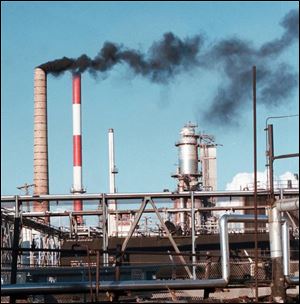
Lucas County likely to fail latest air standards
12/21/2005
Back in 1998, the Sunoco Oil Refi nery in East Toledo poured black smoke into the air.
Lucas County, which earlier this year thought its soot problem was a thing of the past, now likely will be redeclared out of compliance for ultrafine particulate matter, an Ohio environmental official said.
The U.S. Environmental Protection Agency yesterday tweaked its upcoming standard for such pollution - the most common source of which is from coal-fired power plants, manufacturing facilities, and vehicle exhausts - on the very last day it was allowed to do so by court order.
The EPA officials said they plan to stick with the yearly averaging standard of 15 micrograms per cubic meter for particles 2 1/2 microns or less.
But more significantly, they said they plan to tighten the existing 24-hour threshold, bringing the current limit of 65 micrograms per cubic meter to a new daily limit of 35 micrograms per cubic meter.
Changes also were announced for the ways in which the U.S. EPA will regulate bigger particles, those which are 2 1/2 microns to 10 microns.
Linda Oros, an Ohio EPA spokesman, said the state agency had no immediate response beyond an acknowledgment that Lucas as well as Lake and Trumbull counties likely will be back out of compliance.
The effect on Michigan counties was not immediately known.
The issue is one in which the U.S. EPA is to set a new public health standard based on the latest scientific evidence and technology.
Particulate matter is one of six major forms of air pollution in which regulations are supposed to be revisited at least once every five years, although records show that has rarely happened since the Clean Air Act took effect in 1972.
The drawback is the potential economic effect.
Tougher controls drive up costs and, thus, make it harder for affected cities to expand their manufacturing base, officials have said.
Particles that are 2 1/2 microns or less are rarely seen without a microscope. They are 1/30th the width of a human hair. But the U.S. EPA has said they are among the most dangerous forms of air pollution because they can be inhaled deep into the lungs and cause a lifetime of respiratory distress - even death.
Lucas and Wood counties were among 225 counties nationwide that were declared out of compliance for sooty particulate matter on Dec. 17, 2004.
But after reviewing material submitted from a contingent that included the Ohio EPA, U.S. Sen. George Voinovich (R., Ohio), and U.S. Rep. Marcy Kaptur (D., Toledo), the federal agency on April 5 reversed itself by identifying Toledo as one of 12 metropolitan areas that should not have been included on the original list.
Jack Shaner, Ohio Environmental Council spokesman, said he's pleased that a greater number of Ohioans will be protected. But he also said the federal agency made the situation more confusing than it had to be for urban planners and economic developers by tinkering around so much.
David Celebrezze, an outreach coordinator for the group, said he wished the agency would have followed the advice of its clean air scientific advisory committee by setting the annual threshold for particulate matter 2.5 microns or less at 12 micrograms per cubic meter and the daily limit at 25 micrograms per cubic meter.
U.S. EPA Administrator Stephen Johnson acknowledged that the advisory body proposed tougher standards. But Mr. Johnson said he based his decision on the best available science.
John L. Kirkwood, American Lung Association president and chief executive officer, said Mr. Johnson's compromise "falls far short of what is necessary to protect public health."
The lung association's views were echoed by the American Public Health Association, the American Academy of Pediatrics, the American Thoracic Society, and the American College of Cardiology.
The U.S. EPA said it began updating the standards for particulate matter in 1997.
Scott Segal, director of the Electric Reliability Coordinating Council, an industry group that represents coal-fired power plants, said many opponents simply want "more litigation and inflexible regulatory responses."
The rules are to be published in the Federal Register soon, with language finalized by Sept. 27.
Contact Tom Henry at:
thenry@theblade.com
or 419-724-6079.